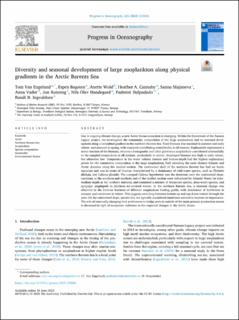| dc.contributor.author | Engeland, Tom Van | |
| dc.contributor.author | Bagøien, Espen | |
| dc.contributor.author | Wold, Anette | |
| dc.contributor.author | Cannaby, Heather Anne | |
| dc.contributor.author | Majaneva, Sanna Kristiina | |
| dc.contributor.author | Vader, Anna | |
| dc.contributor.author | Rønning, Jon S. | |
| dc.contributor.author | Handegard, Nils Olav | |
| dc.contributor.author | Dalpadado, Padmini | |
| dc.contributor.author | Ingvaldsen, Randi Brunvær | |
| dc.date.accessioned | 2023-11-03T10:40:27Z | |
| dc.date.available | 2023-11-03T10:40:27Z | |
| dc.date.created | 2023-06-16T10:07:53Z | |
| dc.date.issued | 2023 | |
| dc.identifier.citation | Progress in Oceanography. 2023, 216 . | |
| dc.identifier.issn | 0079-6611 | |
| dc.identifier.uri | https://hdl.handle.net/11250/3100489 | |
| dc.description.abstract | Due to ongoing climate change, a new Arctic Ocean ecosystem is emerging. Within the framework of the Nansen Legacy project, we investigated the community composition of the large zooplankton and its seasonal development along a latitudinal gradient in the northern Barents Sea. Total biomass was maximal in summer and early winter, and minimal in spring, with copepods contributing considerably in all seasons. Euphausiids represented a minor fraction of the biomass, whereas chaetognaths and other gelatinous zooplankton contributed substantially to the sampled zooplankton at all stations, particularly in winter. Amphipod biomass was high in early winter, but otherwise low. Temperature in the water column interior and bottom-depth had the highest explanatory power for the community composition of the large zooplankton, both revealing the same distinct Atlantic and Arctic domains along the studied section. The continental shelf of the northern Barents Sea had an Arctic signature and was in terms of biomass characterized by a dominance of cold-water species, such as Themisto libellula, and Calanus glacialis. The copepod Calanus hyperboreus was the dominant over the continental slope. Locations at the southern and northern end of the studied section were influenced by Atlantic Water (at intermediate depth at the northern stations), and contained a mixture of temperate species, deep-water species, and sympagic amphipods in northern ice-covered waters. In the northern Barents Sea, a seasonal change was observed in the biomass fractions of different zooplankton feeding guilds, with dominance of herbivores in summer and carnivores in winter. This suggests switching between bottom-up and top-down control through the year. On the continental slope, species that are typically considered omnivores seemed to increase in importance. The role of seasonally changing food preferences to bridge periods outside of the main primary production season is discussed in light of ecosystem resilience to the expected changes in the Arctic Ocean. | |
| dc.language.iso | eng | |
| dc.title | Diversity and seasonal development of large zooplankton along physical gradients in the Arctic Barents Sea | |
| dc.title.alternative | Diversity and seasonal development of large zooplankton along physical gradients in the Arctic Barents Sea | |
| dc.type | Peer reviewed | |
| dc.type | Journal article | |
| dc.description.version | publishedVersion | |
| dc.source.pagenumber | 18 | |
| dc.source.volume | 216 | |
| dc.source.journal | Progress in Oceanography | |
| dc.identifier.doi | 10.1016/j.pocean.2023.103065 | |
| dc.identifier.cristin | 2155182 | |
| dc.relation.project | Norges forskningsråd: 276730 | |
| cristin.ispublished | true | |
| cristin.fulltext | original | |
| cristin.qualitycode | 1 | |
